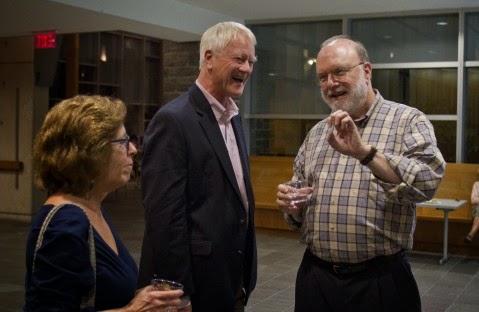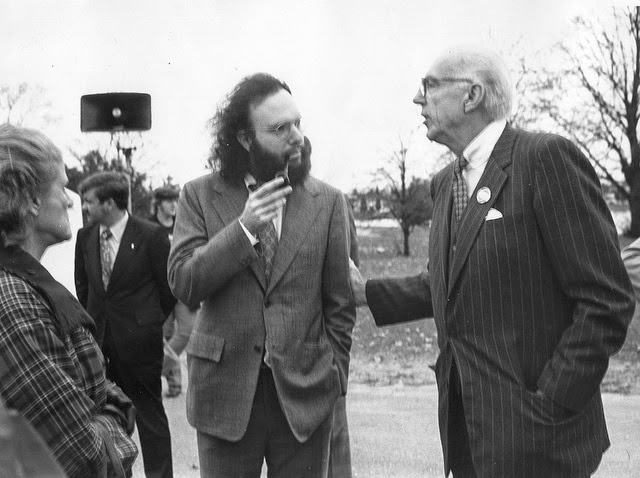I had intended to start my series on Bad Apple Lawyers with the current head of the Brady Center’s Legal Action Project, Jonathan E. Lowy. However, the more I read, the more I was convinced that I needed to go back further to the law professor who helped initiate the use of lawfare against the gun industry with his novel legal theory. That professor is David Kairys of Temple University School of Law.
 |
| Kairys (right) after a recent lecture at Swarthmore College |
Just as the Communist revolutionaries Lenin and Mao needed the theorist Karl Marx for their revolutions, so, too, did the tort attorneys need the theories of David Kairys for their attack on the gun industry in conjunction with anti-gun mayors. Kairys, who made his name in the 60s, 70s, and 80s as a civil rights lawyer, advanced the theory that gun makers and dealers could be sued on the grounds that they were creating a public nuisance through “irresponsible marketing of handguns”.
 |
| A younger Kairys (center) with his client Dr. Benjamin Spock (right) |
According to Howard Erichson, in the book Suing the Gun Industry: A Battle at the Crossroads of Gun Control and Mass Torts , Kairys first brought his theory to the City of Philadelphia and then-Mayor Ed Rendell. In turn, he was hired to draft the complaint. However, just before Kairys and the legal team were to file the lawsuit, Rendell got cold feet in the face of criticism as well as his own desire to be governor of Pennsylvania. Kairys had to look elsewhere to peddle his theory of guns as a public nuisance.
, Kairys first brought his theory to the City of Philadelphia and then-Mayor Ed Rendell. In turn, he was hired to draft the complaint. However, just before Kairys and the legal team were to file the lawsuit, Rendell got cold feet in the face of criticism as well as his own desire to be governor of Pennsylvania. Kairys had to look elsewhere to peddle his theory of guns as a public nuisance.
That elsewhere was Chicago where Mayor Richard M. Daley was looking for a way to attack the firearms industry. By happenstance, Kairys heard that Daley’s city lawyers were making inquiries about his theory and he contacted them. Chicago used Kairys public nuisance theory as the centerpiece of the lawsuit that they filed in late 1998. Though Chicago had tough gun control laws, gangs and criminals were still obtaining firearms. Chicago contended that these weapons were coming from unscrupulous gun shops outside the city who engaged in dubious sales. To Kairys’ and Chicago’s mind, this constituted a public nuisance for which the city was entitled to stop.
Mass tort actions, especially those brought by plaintiffs’ attorneys (aka ambulance chasers), depend upon a large number of individuals harmed. When dealing with asbestos or tobacco, it was easier to find potential clients. However, when dealing with gun shot victims, there are many fewer and it was harder to line up potential clients. Thus the alliance with municipalities was critical for both the private plaintiffs attorneys who handled cases for New Orleans and other locales and for those who used Kairys’ public nuisance theory. By taking the focus off the individual and putting it on a mass group, the “blame the smoker” approach of defense attorneys is harder to employ. Erichson noted this in his essay for Suing the Gun Industry.
As a matter of causation, plaintiffs in individual gun cases have difficulty proving that different industry conduct would have prevented a particular victim’s shooting. Municipal gun lawsuits, by treating the harm on an aggregate level in terms of cost to the municipality, remove attention from any individual shooting and thus diminish the power of the defense arguments that focus on blameworthy victims, owners, or shooters. Thus, the public entity plaintiff in tobacco litigation is less vulnerable to to the defendants’ “blame the smoker” argument for contributory negligence, comparative fault, or assumption of risk, while the public entity plaintiff in gun litigation is less vulnerable to the defendants’ “blame the shooter” argument for superseding cause or for challenging actual causation.
In a discussion of the firearms lawsuits of the late 90s and early 200s, Kairys himself notes that the predominant legal theory of public nuisance was new. It was also a unique tort which had as its hallmark the incompatibility of the defendant’s conduct with the public’s rights. Normally, when one thinks of a public nuisance, you think of unkempt homes, air and water pollution, and crack houses. Kairys contended that firearms manufacturers intentionally saturated the market with small and, in his words, crime-friendly, handguns knowing that some dealers and distributors allowed diversion to criminals through straw purchases or outright illegal sales. He further contended that manufacturers knew or should have known who the problem dealers were due to requests for gun traces from the ATF.
Kairys laid out his theory in a number of law journal articles and book chapters. The quote below comes from his essay, “The Cities Take the Initiative: Public Nuisance Lawsuits against Handgun Manufacturers.”
The conduct that forms the basis of the claim is their distribution of handguns. The public nuisance is not handguns or criminals but those items in combination – criminals and youths with handguns – a combination that the manufacturers facilitate with full knowledge of what they are doing and of the consequences.
He said that three of the recognized grounds for establishing the public nuisance tort apply to the gun makers. First, they interfere with public safety given the criminal misuse of handguns. Second, he accuses them of reckless conduct by continuing to sell to distributors or dealers they “know” are doing the most harm. Finally, he says manufacturers’ actions are “unreasonable on the totality of the circumstances.” That is, there is no legitimate interest in criminals or prohibited persons getting guns and that the gun makers only care about their profits. He says that the makers could take “reasonable actions” by refusing to sell to certain dealers or distributors that they “know” are conduits to criminals.
Congress decided that both the public nuisance theory and product defect theory were flawed when applied to the firearms industry. They passed the Protection of Lawful Commerce in Arms Act in 2005 as a response to this misuse of the courts. Kairys railed against the law’s passage in an article in Slate in which he said the Congress and the President had given the gun industry “immunity from the rule of law.”
It was not only Congress that thought the public nuisance theory flawed. So too did the Illinois Supreme Court when it agreed with the trial court that the dismissal of City of Chicago v. Beretta was warranted. They said, in conclusion, that:
Any change of this magnitude in the law affecting a highly regulated industry must be the work of the legislature, brought about by the political process, not the work of the courts. In response to the suggestion of amici that we are abdicating our responsibility to declare the common law, we point to the virtue of judicial restraint.
Even with rulings like Beretta (above) and the PLCAA, the public nuisance theory is not dead. In the recently dismissed Phillips et al v. Lucky Gunner et al, the Brady Center and their associated attorneys still clung, in part, to this theory. They accused Lucky Gunner and the other defendants of violating Colorado and Aurora laws and ordinances concerning public nuisances. They also asked the court for an order “enjoining or abating the public nuisance.”
Kairys is 72 years old now. He graduated from Cornell in 1965, from Columbia Law in 1968, and took a LLM from U.Penn in 1971. In addition to his work on gun control, he is the editor of The Politics of Law: A Progressive Critique which is now in its third edition. As I alluded to in the first picture, he defended Dr. Benjamin Spock in a free speech case during the Vietnam War. He also has written a memoir of his days as a civil rights lawyer in Philadelphia fighting the Philly PD and Mayor Frank Rizzo called Philadelphia Freedom. He donated his papers to the University of Pennsylvania.
Kairys is married to Antje Mattheus. She is a German immigrant who came to the US in 1974 to work with the United Farm Workers Union. She has written about non-violent self-defense for Waging Nonviolence. Kairys met Mattheus when he represented her in a “post-demonstration incident with State Police.” Together they have been restoring Cresheim Farm in the Mt. Airy section of Philadelphia since 1988.
David Kairys’ contribution to the anti-Second Amendment forces was his theory on controlling gun makers as a public nuisance. It was the basis for many of the municipal lawsuits and is still being used by the Brady Center today in their “Bad Apple” lawsuits. It is a shame that a civil rights attorney who seemingly had great respect for the First Amendment and individual rights has so little respect for the Second Amendment. Unfortunately, that dichotomy is altogether much too common among so-called progressives.


